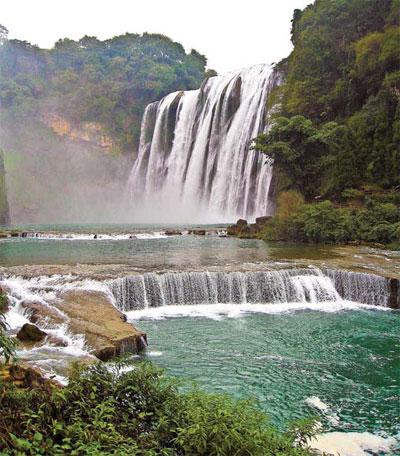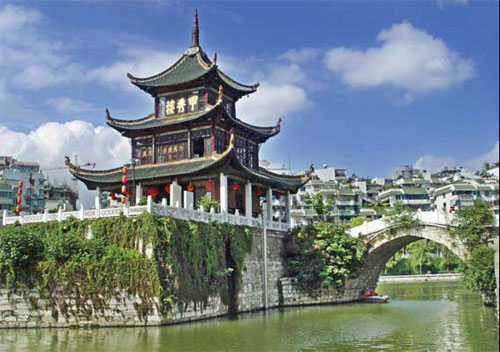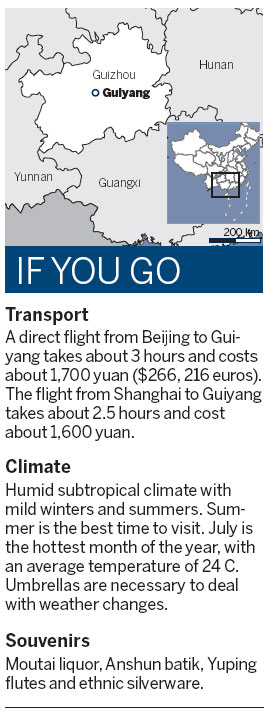|
|

Huangguoshu waterfall is one of the biggest of its kind in the world. Photos provided to China Daily
|
|

Jiaxiu pavilion stands on a tortoise-shaped rock in the Nanming River.
|
Subtropical city offers summer getaway rich in natural and ethnic delights
Guiyang is the capital of Guizhou province, which conjures up Chinese images of terraced rice fields, winding steams, lush waterfalls, surreal stone forests and verdant sun-bathed hills and slopes.
Guiyang itself means precious sun, which also reflects the city's rainy climate. But at an altitude of about 1,100 meters, its pleasantly cool weather draws millions of tourists every year to escape the summer heat.
Its surrounding regions, some of which are inhabited by several of China's largest ethnic communities, are characterized by the limestone landscape dotted with historic relics.
The provincial capital is becoming an economic heavyweight in the region, with retail and commercial activities adding to large minerals and chemicals sectors as well as pharmaceuticals industry.
Here are some of the main attractions:
1. Jiaxiu pavilion
Built in 1598, this pavilion stands on a tortoise-shaped rock in the Nanming River, south of the city. It includes three parts: Fuyu bridge, the pavilion's main building and Cuiwei garden. The pavilion is 29 meters high with gradually indenting three-storied eaves and white marble railings.
The builder, Jiang Dongzhi, was an imperial inspector. The pavilion served as a gathering spot for ancient scholars preparing for the imperial civil service examinations and has been refurbished into a teahouse with antique displays.
Its rich collection of stone engravings, calligraphy works, paintings and woodworks are also a must-see, among which the 206-character-long couplet written by Liu Yushan of the Qing Dynasty (1644-1911) is the most famous as well as the longest in the world.
The pavilion's top floor offers a panoramic view of downtown Guiyang.
2. Qingyan ancient town

Qingyan is located in Guiyang's southern suburb. Originally built in 1378, it draws tourists with its distinctive architecture, built entirely of stone.
Zhu Yuanzhang, the first emperor of the Ming Dynasty (1368-1644), established the town for military reasons. It later prospered as a merchant hub in the region with rich cultural features of the Ming and Qing dynasties. Stone folk houses and winding cobblestone streets dot the town protected by stone city walls.
3. Huangguoshu waterfall
Lying 137 km southwest of Guiyang, Huangguoshu waterfall is one of the biggest waterfall groups in the world, consisting of 18 surface falls and four underground ones. The largest waterfall is 83 meters wide and 67 meters high.
Legend says that in ancient times, the sky suddenly cracked open, with pieces of the Milky Way falling to the earth. The largest piece fell on a cliff and became Huangguoshu waterfall.
Water gushes down from a cliff into Xiniu Pool at more than 700 cubic meters of water a second. The rapids send up spray of up to 100 meters high and diffract the light on sunny days, often creating rainbows that can make you forget the outside world. Watching the waterfall against misted mountains and the setting sun is a fascinating experience.
4. Dragon Palace
About 130 km from Guiyang lies the huge Dragon Palace cave. This feature covers 60 sq km with more than 90 karst caves in which stalactites hang and an underground river runs.
The cave is so named because it looks like the crystal palace where the dragon king lives in Chinese myths. The underground river stretches 5,000 meters, runs through more than 20 hills and connects more than 90 limestone caves.
The river is also wide and deep enough for small boats. Travelers can ride on a boat in the gate lake and enter the cave to enjoy the spectacular stalactites.
5. Xijiang Miao village
Travel east from Guiyang to Leixian county to find one of China's largest Miao ethnic groups in a village amid an undulating but continuous row of Miao houses, spreading from the top of the hills to its foot.
The Miao people have more than 100 festivals, the most famous being the Lusheng Festival, the Miao New Year and Sisters' Meal Festival. Lucky travelers can join in their celebrations.
During the festivals, Miao women wear large silver neck rings, necklaces, earrings and bracelets, as part of the song and dance.
Eating and drinking
Sour fish soup is one of Guizhou's most famous dishes. Boiled with tomato sauce and local Chinese herbs, the fish is mellowed with a mixture of spices. It can be served with a selection of tofu and other vegetables. A few famous restaurants are located in Shengfu Road, Guiyang.
Beef noodle soup is another staple. It is made of stewed beef, rice noodles, beef broth and vegetables. Huaxi Beef Rice Noodles restaurant is the most well known in town, with several branches in Guiyang's downtown area.
China Daily
(China Daily 08/03/2012 page22)
|